Boston Public Library, McKim Building
|
Boston Public Library | |
|
Boston Public Library, McKim Building in Copley Square | |
| Location | Boston, Massachusetts |
|---|---|
| Coordinates | 42°20′58″N 71°4′41″W / 42.34944°N 71.07806°WCoordinates: 42°20′58″N 71°4′41″W / 42.34944°N 71.07806°W |
| Built | 1895 |
| Architect |
Charles Follen McKim; McKim, Mead and White |
| Architectural style | Renaissance Revival, Beaux-Arts |
| Part of | Back Bay Historic District (#73001948) |
| NRHP Reference # | 73000317 |
| Significant dates | |
| Added to NRHP | May 6, 1973[1] |
| Designated NHL | February 24, 1986 |
| Designated CP | August 14, 1973 |
The Boston Public Library McKim Building (built 1895) in Copley Square contains the library's research collection, exhibition rooms and administrative offices. When it opened in 1895, the new Boston Public Library was proclaimed a "palace for the people." The building includes lavish decorations, a children's room (the first in the nation), and a central courtyard surrounded by an arcaded gallery in the manner of a Renaissance cloister. The library regularly displays its rare works, often in exhibits that will combine works on paper, rare books, and works of art. Several galleries in the third floor of the McKim building are maintained for exhibits.

History
Boston Public Library was founded in 1852. The first Boston Public Library location opened in 1854 in two rooms in the Adams School on Mason Street. Because the Mason Street space was small and poorly lit, a new building opened at 55 Boylston Street in 1858. It cost $365,000 to build and held 70,000 volumes. By 1880, the Boston Public Library again needed a larger building to accommodate its holdings, and architect Charles Follen McKim of McKim, Mead, and White was chosen to design a new building at the corner of Dartmouth Street and Boylston Street. It opened in 1895 and cost $2,268,000, with a capacity of 2 million books.[2]
Architecture
Charles Follen McKim's design shows influence from a number of architectural precedents. McKim drew explicitly on the Bibliothèque Sainte-Geneviève in Paris (designed by Henri Labrouste, built 1845 to 1851) for the general arrangement of the facade that fronts on Copley Square, but his detailing of that facade's arcaded windows owes a clear debt to the side elevations of Leon Battista Alberti's Tempio Malatestiano in Rimini. The open-air courtyard at the center of the building is based closely on that of the sixteenth-century Palazzo della Cancelleria in Rome. McKim also exploited up-to-date building technology, as the library represents one of the first major applications, in the United States, of the system of thin tile vaults (or catalan vaults) exported from the Catalan architectural tradition by the Valencian Rafael Guastavino. Seven different types of Guastavino vaulting can be seen in the library.[3]
The McKim building was listed on the National Register of Historic Places in 1973, was designated a National Historic Landmark in 1986 for its architectural and historical significance, given Boston Landmark status by the Boston Landmarks Commission in 2000. It was the first major Beaux Arts building in the United States, and it was also the first large-scale urban library building in the nation.[4]
Murals
Murals include recently restored paintings by John Singer Sargent on the theme of The Triumph of Religion;[5] Edwin Austin Abbey's most famous work, a series of murals which depict the Grail legend; and paintings of the Muses by Pierre Puvis de Chavannes.
Monumental inscriptions
McKim chose to have monumental inscriptions, similar to those found on basilicas and monuments in ancient Rome, in the entablature on each of the main building's three façades. On the south is inscribed: "MDCCCLII • FOUNDED THROUGH THE MUNIFICENCE AND PUBLIC SPIRIT OF CITIZENS"; on the east: "THE PUBLIC LIBRARY OF THE CITY OF BOSTON • BUILT BY THE PEOPLE AND DEDICATED TO THE ADVANCEMENT OF LEARNING • A.D. MDCCCLXXXVIII"; and on the north: "THE COMMONWEALTH REQUIRES THE EDUCATION OF THE PEOPLE AS THE SAFEGUARD OF ORDER AND LIBERTY". The last quotation has been attributed to the library's Board of Trustees.
Another inscription, above the keystone of the central entrance, proclaims: "FREE TO ALL". Below each second-story arched window on the three façades are inscribed lists of the names of great historical writers, artists, scientists, philosophers, and statesmen.
Across the street from the central entrance to the library is a twentieth-century monument to the Lebanese-born poet and philosopher Kahlil Gibran who as a young immigrant educated himself in the Boston Public Library. The monument's inscription responds to the McKim building reading "IT WAS IN MY HEART TO HELP A LITTLE, BECAUSE I WAS HELPED MUCH". The text is excerpted from a letter enclosed with Gibran's generous bequest to the library.
Bates Hall
Bates Hall is named for the library's first great benefactor, Joshua Bates. Boston Globe writer Sam Allis described "Bates Hall, the great reading room of the BPL, vast and hushed and illuminated with a profusion of green lampshades like fireflies" as one of Boston's "secular spots that are sacred." [6] The form of Bates Hall, rectilinear but terminated with a semi-circular apse on each end, recalls a Roman basilica. A series of robust double coffers in the ceiling provide a sculptural canopy to the room. The east side has a rhythmic series of arched windows with light buffered by wide overhanging hood on the exterior. Heavy deep green silk velvet drapery installed in 1888, and again in the 1920s and 1950s, was not recreated in the 1993 restoration of the room. The drapery helped to muffle sound and lower light levels.
Research collection
Included in the BPL's research collection are more than 1.7 million rare books and manuscripts. It possesses wide-ranging and important holdings, including medieval manuscripts and incunabula, early editions of William Shakespeare (among which are a number of Shakespeare quartos and the First Folio), the George Ticknor collection of Spanish literature, a major collection of Daniel Defoe, records of colonial Boston, the 3,800 volume personal library of John Adams, the mathematical and astronomical library of Nathaniel Bowditch, important manuscript archives on abolitionism, including the papers of William Lloyd Garrison, and a major collection of materials on the Sacco and Vanzetti case. There are large collections of prints, photographs, postcards, and maps. The library, for example, holds one of the major collections of watercolors and drawings by Thomas Rowlandson. The library has a special strength in music, and holds the archives of the Handel and Haydn Society, scores from the estate of Serge Koussevitzky, and the papers of the important American composer Walter Piston.
See also
- Boston Public Library
- List of National Historic Landmarks in Boston
- National Register of Historic Places listings in northern Boston, Massachusetts
Notes
- ↑ National Park Service (2006-03-15). "National Register Information System". National Register of Historic Places. National Park Service.
- ↑ Catherine J. Willis (2011). Boston Public Library. Arcadia Publishing. pp. 8–10. ISBN 978-0-7385-7506-3.
- ↑ Shand-Tucci. 2002
- ↑ "NHL nomination for Boston Public Library" (PDF). National Park Service. Retrieved 2015-02-19.
- ↑ John Singer Sargent's "Triumph of Religion" at the Boston Public Library: Creation and Restoration, Edited by Narayan Khandekar, Gianfranco Pocobene, and Kate Smith, Harvard Art Museum, Cambridge MA and Yale University Press, New Haven, 2009
- ↑ Allis, Sam (2005): "Holy Hub's hot spots: Fenway Park and other secular spots that are sacred." Boston Globe, December 4, 2005, p. A3
Further reading
- Willis, Catherine J. "Boston Public Library" (Images of America series). Arcadia Publ, 2011.
- Small, Herbert (compiler). Handbook of the new Public library in Boston. Boston: Curtis & Co., 1895.
- Peter Wick. A handbook to the art and architecture of the Boston Public Library. 1977.
- Shand-Tucci, Douglass, "Renaissance Rome and Emersonian Boston: Michelangelo and Sargent, between Triumph and Doubt", Anglican Theological Review, Fall 2002, 995-100
External links
| Wikimedia Commons has media related to Boston Public Library, McKim Building. |
- The Boston Public Library
- A Tribute to the Boston Public library
- Boston Public Library: architectural images
- Great Buildings on-line
- Photos of the Boston Public Library
- Trustees' McKim Construction Photos The Boston Public Library's McKim Construction Photos on Flickr.com
- City of Boston, Landmarks Commission. Boston Public Library Study Report, 2000
Image gallery
 Laying cornerstone, 1888
Laying cornerstone, 1888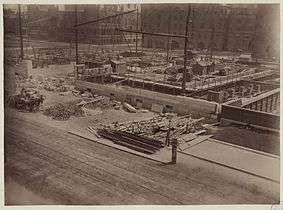 Under construction, 1889
Under construction, 1889 First floor plan
First floor plan Under construction, 1890
Under construction, 1890 Bates Hall in the late 19th century
Bates Hall in the late 19th century Exterior view
Exterior view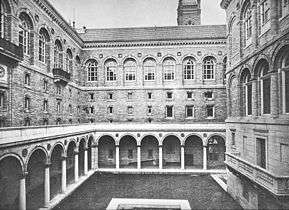 Courtyard of the McKim building looking north. The campanile of Old South Church can be seen.
Courtyard of the McKim building looking north. The campanile of Old South Church can be seen.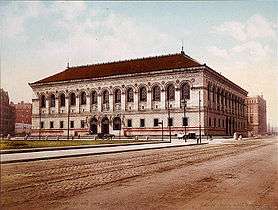 Early postcard
Early postcard Copley Square, 1920
Copley Square, 1920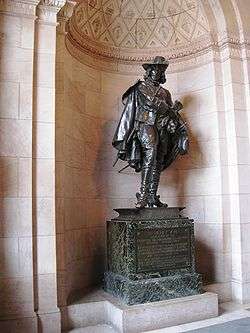 Henry Vane sculpture
Henry Vane sculpture.jpg) Detail, Daniel Chester French's 1904 bronze door, "Knowledge." At the base of the door, Proverbs 24:3: "By knowledge shall the chambers be filled with all pleasant and precious riches."
Detail, Daniel Chester French's 1904 bronze door, "Knowledge." At the base of the door, Proverbs 24:3: "By knowledge shall the chambers be filled with all pleasant and precious riches."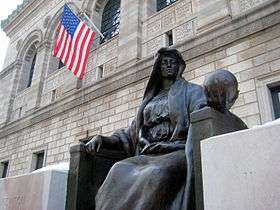 Personification of "Science" at main entrance
Personification of "Science" at main entrance- Dancing Bacchante and Infant Faun, by Frederick William Macmonnies, in the library's courtyard, ca.2006. It is one of his most famous sculptures.
 2007
2007 Entrance stairway, ca.2010
Entrance stairway, ca.2010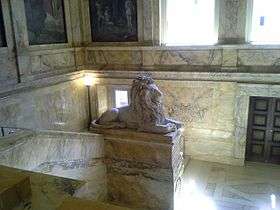 Looking down at the entrance stairway to the McKim Building (2014)
Looking down at the entrance stairway to the McKim Building (2014)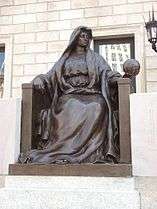 Statue of Science, Boston Public Library, 28 June 2014
Statue of Science, Boston Public Library, 28 June 2014


